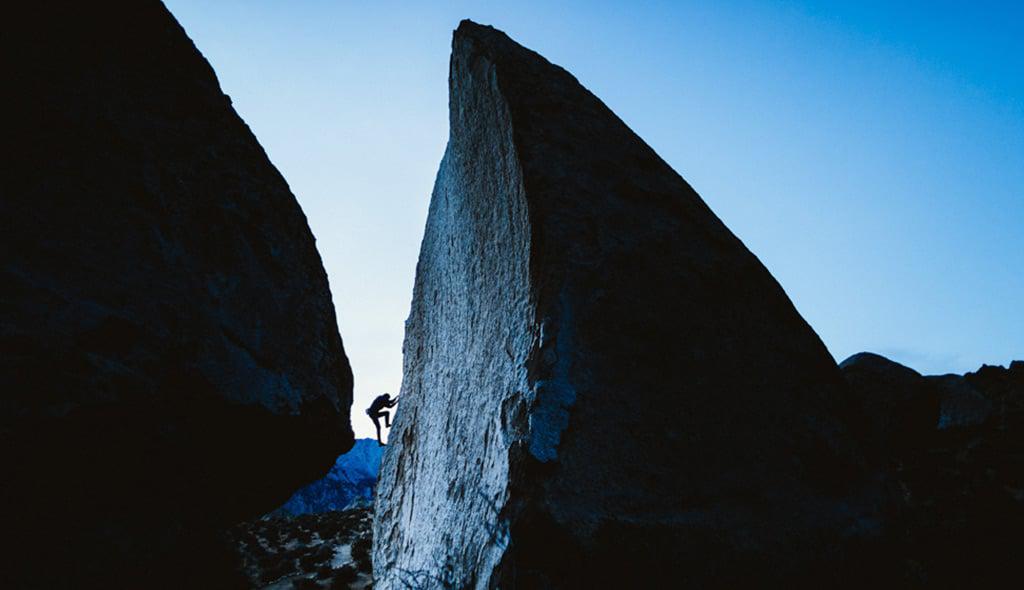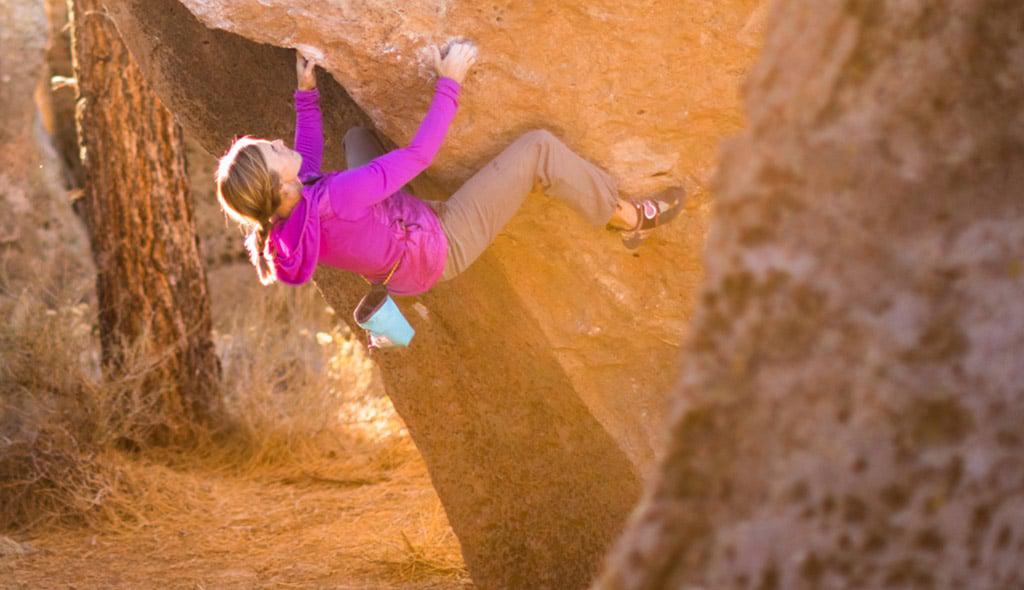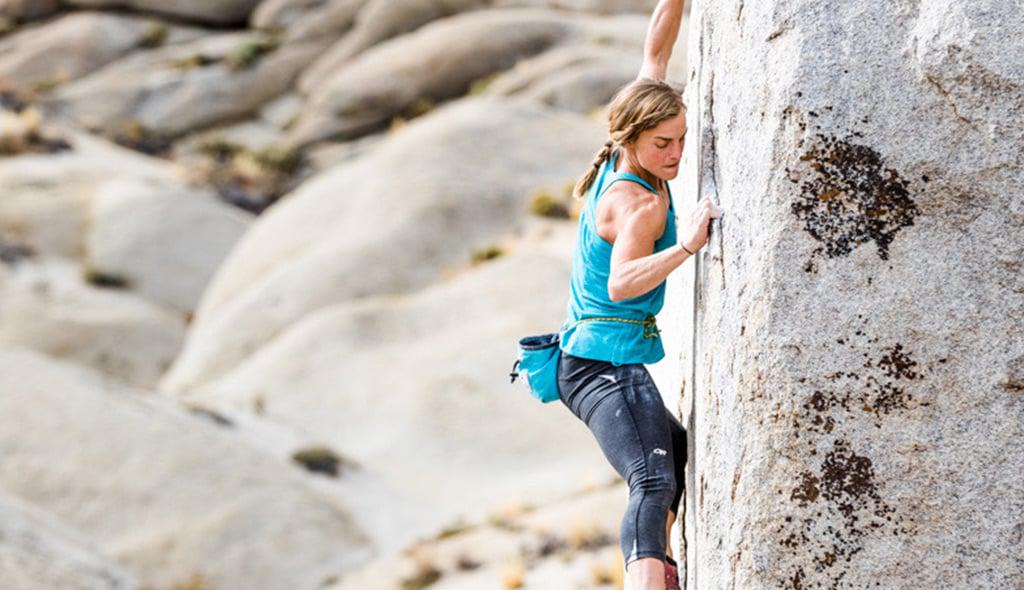[caption id="" align="alignnone" width="1024"] Photo credit: Forest Woodward | Model: Jenny Abegg[/caption] Rock climbing comprises a number of different disciplines, ranging from alpine big wall climbing to cragging to bouldering. Bouldering is arguably the simplest and purest form of climbing. With only the chalk on their hands and the shoes on their feet, boulderers focus solely on movement as they attempt to traverse or top out rocks of various shapes and sizes. Today, bouldering has become extremely popular for a variety of reasons:
Photo credit: Forest Woodward | Model: Jenny Abegg[/caption] Rock climbing comprises a number of different disciplines, ranging from alpine big wall climbing to cragging to bouldering. Bouldering is arguably the simplest and purest form of climbing. With only the chalk on their hands and the shoes on their feet, boulderers focus solely on movement as they attempt to traverse or top out rocks of various shapes and sizes. Today, bouldering has become extremely popular for a variety of reasons:
- Focus on movement: Boulderers can zero in on the minutiae of body positioning, trying hard, and sequenced movements in a more focused way than other forms of climbing.
- Inexpensive: No need to buy a harness, ropes, or hardware; new boulderers can get started with a pair of shoes and some friends with crash pads.
- Little training needed: Forget learning how to tie knots and build anchors; boulderers simply need a crash course in proper falling and spotting technique before getting on the rock.
- Accessible & low commitment: Boulders are far more ubiquitous and accessible than mountain ranges, and approaches to bouldering areas are generally short. As boulder problems take mere seconds to complete, the sport is low-stress and does not require full or multi-day commitment. (Note: bouldering “problems” is a term used to describe the path a climber takes to complete a climb.)
- Social: Bouldering is certainly the most social form of climbing — the more the merrier, and groups stick together to spot each other rather than spreading out a rope length apart.
Bouldering is where many climbers get started, where veteran climbers train strength, and where the world’s strongest climbers test their abilities. I’ve been climbing now for almost a decade, and came into climbing as an alpine trad climber. Now, along with ascending high peaks, I find myself bouldering consistently to train my body to do harder moves, to enjoy low-stress days on the rock, and to spend time with friends. If you’re thinking of trying out bouldering or you’ve been doing it for a bit but have some questions, read on for my answers to frequently asked bouldering questions.
What bouldering lingo do I need to know when it comes to boulder types?
Boulders come in all shapes and sizes — some bouldering is even done on short cliff bands — and is practiced on a variety of rock types. Here is some lingo that you might hear climbers using to describe boulders:
- Arête: The opposite of an inside corner; a protruding feature often forming a sharp angle
- Dyno: a jumping move in which, for a moment, the body has no point of contact with the rock
- Crimp: a very small edge
- Sloper: a rounded or sloping handhold
- Face: a flat vertical surface, often requiring crimping and delicate, technical footwork
- Slab: a flat angled surface, requiring trust of feet and delicate footwork
- Overhang: rock that is steeper than vertical
- Traverse: a problem that involves moving sideways, often requiring endurance
- Compression: a technique that requires a climber to use their hands or feet to squeeze a feature on both sides
- Highball: a notably tall boulder problem in which a fall might result in injury; usually 20 feet or higher
How are ratings and beta used in bouldering?
Bouldering ratings can be especially finicky, as the movement is so particular and might be drastically different for varying body types. Because it is so condensed, bouldering movement is generally more difficult than sport/trad climbing; don’t hesitate to start on the easiest problems. In the U.S., we use the V Scale to assign problems difficulty ratings:
- VB is the easiest (5.8 moves and easier).
- The scale then goes from V0 to V17 (until someone climbs V18!).
- Pluses (+) and minuses (-) can be added to the grade for more specificity.
In bouldering, more than in any other discipline of climbing, climbers fail a great deal before completing all the moves (in climber lingo, this is called projecting and sending the route). Boulderers are known to watch YouTube videos of their projects and profusely swap beta with other climbers. In general, it’s best to ask permission before volunteering your two cents, and is completely acceptable to inquire with other climbers for beta.
What do I need in order to boulder safely?
[caption id="" align="alignnone" width="1024"] Photo credit: Forest Woodward | Model: Jenny Abegg[/caption] Boulderers require two things to ensure their safety: crash pads and spotters. Both of these precautions are not to be taken lightly; spotting and padding routes is a fine art when done well.
Photo credit: Forest Woodward | Model: Jenny Abegg[/caption] Boulderers require two things to ensure their safety: crash pads and spotters. Both of these precautions are not to be taken lightly; spotting and padding routes is a fine art when done well.
- Crash pads: these are thick pads that fold and can be carried as a backpack. Crash pads are placed in the fall zone and more often than not, multiple are needed to effectively protect a fall.
- Spotters: The job of spotters is not to catch the falling climber, but to direct them onto the crash pads, feet first. The more spotters, the better.
How can I prevent injuries?
Boulderers are more prone to injury than other climbers, both because of the potential to fall to the ground and the intensity of movement resulting in wear and tear on various parts of the body. Proper padding and spotting can do a great deal to prevent falling injuries, and the following are ways to mitigate common skin, finger, arm, and shoulder injuries.
Warm up
Before getting on a difficult project, a combination of light cardio, dynamic stretching, and climbing on problems well under a climber's limit will greatly help prevent injury.
Rest
If you’re bouldering at your limit, you will spend far more time on the ground resting than you will on the rock. Embrace rest as a part of performance. Rest times may vary based on exertion, but make sure you feel strong, recovered, and able to give 100 percent effort before you attempt the problem again. Additionally, days of rest might be needed to properly recover from difficult sessions.
Taping
If you experience finger pain or weakness and still want to climb (although perhaps rest and ice is a better option), taping problem fingers can add a great deal of support.
Skin care
I could write a book on skin care, but generally, climbers use a variety of lotions, sanding, taping, and super glue in order to deal with thin skin or split tips. Learn more about about climbing skin care here.
How should I train for bouldering?

Beginner climbers and boulderers often wonder, “How can I get stronger?” In my opinion, the best thing you can do in your first year or two as a climber is just climb, a lot. As new climbers are still learning technique, developing a great deal of strength will likely distract from this progression. When a climber reaches the point where they feel that a lack of strength and power — not technique — is preventing them from progressing, training will be beneficial. All of these exercises should be heavily researched beforehand and done with the utmost attention to proper form and good rest to avoid injury. Each climber has their own theory of training, but below is what has worked for me.
Hangboarding
It’s amazing how hanging on small holds for up to 10 seconds, over and over, can develop finger strength. Climbers should add or subtract weight using a harness and pulley system to be close to failing at the end of each session.
Limit bouldering
Essentially, condensed bouldering, limit bouldering is repeating five moves or less that are slightly above your limit. After each attempt, rest and analyze the micro-beta that needs to change in order to perfect the movement. To avoid injury, only spend 15-20 minutes on a sequence before moving on to another sequence with different movement.
Campus boarding
Start simple on the campus board — this tool is known to cause injury in new climbers. At first you might just be doing deadhangs or pull-ups, and then progressing to up/downs, ladders, bumps, and ladder traverses.
What etiquette do I need to know?
The Access Fund is a national climbers’ organization that protects and creates access to climbing areas across the country. As part of a recent campaign to educate the growing community of gym climbers on proper outdoor practices, it created The Pact:
- Respect other users.
- Dispose of human waste properly.
- Park and camp in designated areas.
- Stay on established trails.
- Place gear and pads on durable surfaces.
- Clean up chalk and tick marks.
- Keep a low profile, minimizing group size and noise.
- Pack out all trash, crash pads and gear.
- Respect closures.
- Be an upstander, not a bystander.


